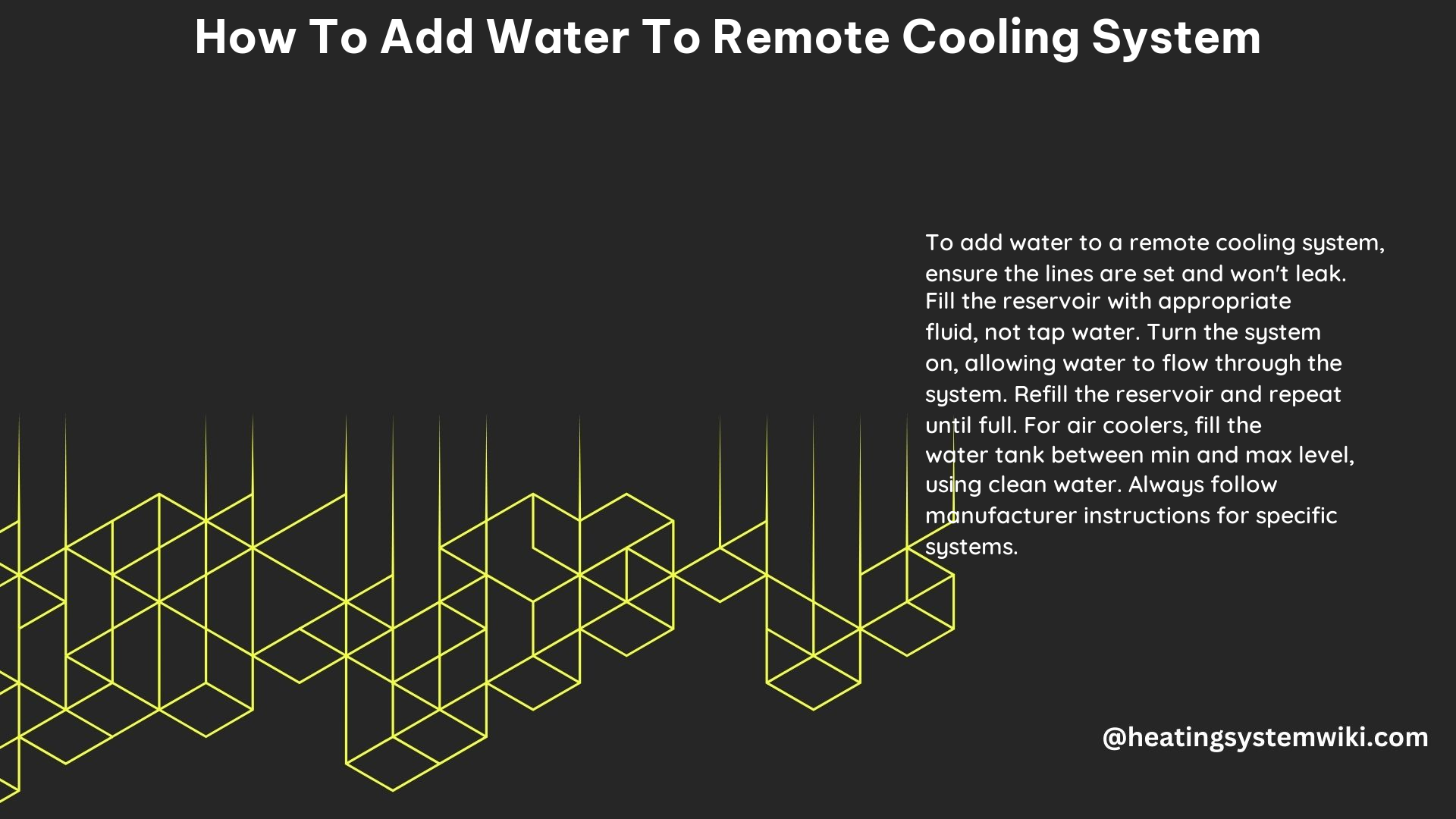Adding water to a remote cooling system is a critical task that requires careful attention to detail and precision. These systems are commonly used in commercial and industrial settings, such as data centers, server rooms, and large-scale manufacturing facilities, to cool down spaces or equipment by circulating chilled water through a network of pipes.
Identify the Type of Cooling System
The first step in adding water to a remote cooling system is to identify the type of system you have. Remote cooling systems can be either open or closed systems. Open systems are designed to allow water to be added or removed as needed, while closed systems are sealed and do not allow for water addition or removal. Determining the type of system you have is essential before attempting to add water.
Locate the Water Fill Point

Remote cooling systems typically have a water fill point, which is a valve or opening that allows water to be added to the system. The fill point may be located on the cooling tower, chiller, or a separate water tank. Identifying the exact location of the fill point is crucial for the water addition process.
Measure the Water Volume
Before adding water to the system, you need to determine the correct water volume. This can be done by consulting the system’s technical specifications or user manual. The water volume is critical because too much or too little water can affect the system’s performance and efficiency.
According to the technical specifications of a typical remote cooling system, the water volume required to fill the system can range from 50 to 500 gallons (189 to 1,893 liters), depending on the size and capacity of the system. It is essential to follow the manufacturer’s recommendations to ensure the correct water volume is added.
Prepare the Water
The water used in a remote cooling system should be free of impurities and contaminants. It is recommended to use deionized or distilled water to prevent mineral buildup and corrosion. Tap water can be used in emergency situations, but it should be treated with a water conditioner to prevent mineral buildup.
The water quality specifications for a remote cooling system typically include the following:
| Parameter | Recommended Value |
|---|---|
| pH | 6.5 – 8.5 |
| Total Dissolved Solids (TDS) | < 500 ppm |
| Hardness | < 170 ppm as CaCO3 |
| Chloride | < 250 ppm |
| Sulfate | < 250 ppm |
| Silica | < 150 ppm |
Ensuring the water meets these specifications is crucial to maintain the system’s efficiency and prevent damage to its components.
Add the Water
Once you have prepared the water, you can add it to the system through the water fill point. It is essential to add the water slowly and carefully to prevent air from entering the system. Air in the system can cause damage to the pumps and other components.
The recommended water addition rate for a remote cooling system is typically between 2 to 5 gallons (7.6 to 18.9 liters) per minute. Exceeding this rate can lead to air entrainment and potential system issues. It is advisable to monitor the water level during the addition process to ensure the system is filled correctly.
Check the Water Level
After adding water to the system, you should check the water level to ensure it is at the correct level. The water level can be checked using a water level gauge or sight glass. If the water level is too low or too high, you may need to add or remove water accordingly.
The recommended water level for a remote cooling system is typically between 80% to 90% of the total system capacity. Maintaining the water level within this range is crucial for the system’s optimal performance and efficiency.
Start the System
Once you have added water to the system and checked the water level, you can start the system. It is essential to monitor the system closely during the startup process to ensure that it is operating correctly and that there are no leaks or other issues.
During the startup process, you should observe the following parameters:
- Pump operation: Ensure the pumps are running smoothly without any unusual noises or vibrations.
- Water flow: Verify that the water is circulating through the system as expected.
- Temperature: Monitor the inlet and outlet water temperatures to ensure they are within the system’s design specifications.
- Pressure: Check the system’s pressure to ensure it is within the recommended range.
If any issues are detected during the startup process, it is crucial to address them immediately to prevent further damage to the system.
In conclusion, adding water to a remote cooling system requires a methodical approach and attention to detail. By following the steps outlined in this guide, you can ensure the water is added correctly, the system is filled to the appropriate level, and the startup process is executed smoothly. Remember to always refer to the manufacturer’s instructions and technical specifications to ensure the safety and optimal performance of your remote cooling system.
